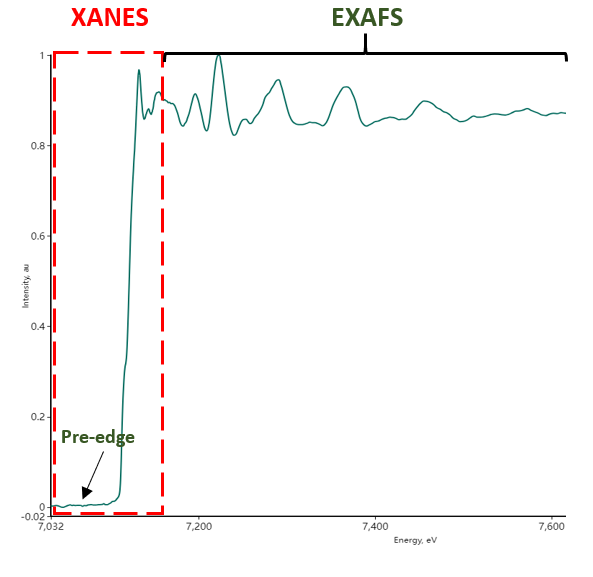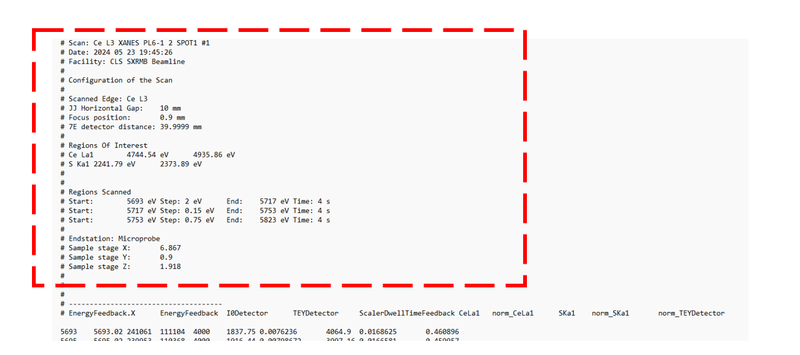Why XAS and how it works?
X-ray absorption spectroscopy (XAS) is an element-specific technique that provides information on the electronic structure, coordination environment, oxidation state and bonding characteristics of elements within materials.
XAS Principle
The principle of this technique is based on scanning the energy of the incident X-rays below and at the energy required to excite a core electron of into unoccupied conduction states (absorption edge) of a selected element and above the absorption edge of the element of interest.
A typical XAS spectrum consists of two regions:
- X-ray absorption near edge spectroscopy (XANES): starts from ~ 10 eV below the absorption edge and usually covers up to 50 eV above the absorption edge, which involves the main-edge feature.
- Extended X-ray absorption fine structure (EXAFS): The EXAFS region occurs when the scanning energy increases from ~ 50 eV above the absorption-edge energy. These oscillations arise from the interference between the outgoing photoelectron wave and the waves scattered by neighboring atoms. This is achieved by analyzing the Fourier transform of the EXAFS data.
- XANES provides information about the oxidation state, electronic structure, bond covalency, and local symmetry of the absorbing atom.
- EXAFS provides details about the particle size, bond lengths, types of neighboring atoms and coordination number of the absorbing atom.
Below is the Fe K-edge spectrum from Fe foil showing XANES and EXAFS regions that collected under TEY mode using SXRMB beamline

For more information on XAS theory watch the XAS tutorial videos:
Fundamentals of X-ray Absorption Spectroscopy
Introduction to Extended X-Ray Absorption Fine Structure (EXAFS)
Source
Synchrotron radiation is often used for XAS due to its high brightness and broad energy range. Laboratory X-ray sources can also be used, but they may have limitations in terms of energy resolution.
Key features
- XAS can be used to study a wide variety of materials such amorphous solids, crystalline materials, solution or liquid samples, biological and environmental samples, and gas molecules.
- Since absorption edges act as fingerprints for each element, XAS allows for the investigation of the chemistry of a specific element without interference from other elements in the sample.
XAS measurements at SXRMB
At SXRMB, XAS spectra can be collected under fluorescence and total electron yield (TEY), photoluminescence, or transmission mode.
Fluorescence vs. transmission mode
- Fluorescence measurements are preferred when the samples have low concentrations (a few ppm) and are very thick or thin.
- Transmission measurements are preferred when the samples are concentrated, thin, and uniform.
Note: if the samples are very concentrated, fluorescence is not a good option as the self-absorption effects can flattened or skewed absorption edges and dampen EXAFS oscillations.
Fluorescence (FY) vs. total electron yield (TEY)
- The TEY mode is surface sensitive since the detected signal is based on the electrons that emitted close to the sample surface (in nm), while FY is ideal for analyzing bulk properties and heterogeneous samples.
Note: TEY does not have significant self-absorption issues because it detects photoelectrons that escape from only the very surface of the sample, avoiding the problem of reabsorption within the sample.
µ-XANES
µ-XANES spectra can also be collected at the SXRMB beamline using a microprobe endstation equipped with a micrometer-sized beam. This technique enables precise elemental mapping of localized regions within a sample, along with collecting µ-XANES spectra from these specific areas to provide detailed chemical and compositional information with high spatial resolution.
Data Analysis
- Data analysis in X-ray Absorption Spectroscopy (XAS) is a critical step in interpreting the raw data collected from experiments and extracting meaningful information about the electronic structure and local environment of the elements in a sample.
- The raw data collected from SXRMB beamline can be directly exported from Acquaman software and are plain ASCII files with .dat extension. The file contains a header with information about the scan parameters, measurement configuration, and columns with data.

For more information on how to read SXRMB data watch this tutorial video:
SXRMB data tutorial
Most common XAS and X-ray microprobe software programs
XAS database
The XAS database is a comprehensive repository for X-ray Absorption Spectroscopy (XAS) data managed by CLS. XAS database is an open resource that provides reference spectra for a wide range of elements and compounds. Researchers can use the XAS database entries to check the consistency of their experimental results with known structures or coordination environments.
X-ray Absorption Spectroscopy (XAS) Database
Helpful tutorials on XAS analysis
- Interpreting XANES data by Bruce Ravel
- A Practical Introduction to Multiple Scattering Theory by Bruce Ravel
- XAS course and Athena data processing by Bruce Ravel
- Larch for XAFS Analysis by Matt Newville
- Anatomy of an XAFS Measurement by Matt Newville
- Fundamentals of XAFS by Matt Newville